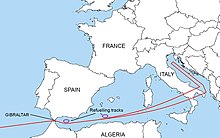Operation Chrome Dome


Operation Chrome Dome was a United States Air Force Cold-War era mission from 1960 to 1968 in which B-52 Stratofortress strategic bomber aircraft armed with thermonuclear weapons remained on continuous airborne alert, flying routes to points on the Soviet Union border.[1]
Background
During the Cold War, General Thomas S. Power, a/k/a "Big Dink," initiated a program whereby B-52s performed airborne alert duty under code names such as Head Start, Chrome Dome, Hard Head, Round Robin,[2] and Operation Giant Lance. Bombers loitered near points outside the Soviet Union to provide rapid first strike or retaliation capability in case of nuclear war.[3][4]
Primary mission
The missions in 1964 involved a B-52D that left Sheppard Air Force Base, Texas and flew across the United States to New England and headed out to the Atlantic Ocean. The aircraft refueled over the Atlantic heading north to and around Newfoundland. The bomber changed course and flew northwesterly over Baffin Bay towards Thule Air Base, Greenland. At this point it flew west across Queen Elizabeth Islands of Canada. Continuing to Alaska, it refueled over the Pacific Ocean again heading south-east and returned to Sheppard AFB.[5]
By 1966, three separate missions were being flown - one East over the Atlantic and the Mediterranean, another north to Baffin Bay, and a third over Alaska.
Military units
The following military units were involved:
- Strategic Air Command Divisions:
- Homestead Air Force Base
- Strategic Air Command in the United Kingdom
- 2nd Bomb Wing, 62nd Bomb Squadron Barksdale AFB, Shreveport, LA
- Strategic Air Command 42 Bomb Wing Loring AFB, Limestone, Maine
Accidents

The program was involved in the following nuclear-weapons accidents:
- 1961 Goldsboro B-52 crash[6]
- 1961 Yuba City B-52 crash
- 1964 Savage Mountain B-52 crash[Notes 1]
- 1966 Palomares B-52 crash
- 1968 Thule Air Base B-52 crash. The Thule accident signaled the end of the program on January 22, 1968.
Notes
- ^ Accident happened while the aircraft was returning to its home base, having already completed its alert mission.
References
- ^ Croddy, Eric; Wirtz, James J. (2005). Weapons of Mass Destruction. ABC-CLIO. ISBN 1-85109-490-3.
The U.S. alert operation, code-named Chrome Dome, was a realistic training mission
{{cite book}}: Invalid|ref=harv(help) - ^ USAF: Lakenheath AFB Libery Wing
- ^ "SAC AIRBORNE ALERT". National Museum of the United States Air Force. 14 January 2009. Archived from the original on 2009-01-14. Retrieved 19 February 2013.
- ^ US Nuclear Weapons Deployments Disclosed, Nautilus Institute
History of the Custody and Deployment of Nuclear Weapons: July 1945 to September 1977 - ^ Nautilus.org: Chrome Dome Route Map
- ^ The Goldsboro Broken Arrow, 2011, ISBN 978-1-257-86952-7
External links
- SAC'S Deadly Daily Dozen at Time Magazine
- 1960 establishments in the United States
- 1960 in international relations
- 1960 in military history
- 1960s in the United States
- 1960s in the Soviet Union
- Nuclear history of the United States
- Nuclear warfare
- Secret military programs
- Soviet Union–United States relations
- Military operations of the Cold War
- United States nuclear command and control
- 1960 in politics
